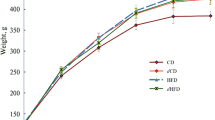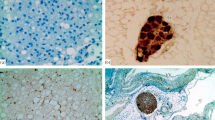Summary
Adult rats maintained at 20–22 °C, were exposed to 4 °C for 30–60 min and injected with 50 or 100 mg/kg 6-hydroxydopamine (6-OHDA) in an attempt to achieve a similar degree of chemical sympathectomy of nerves terminating among the adipocytes and the smooth muscle cells of the blood vessels in the interscapular brown adipose tissue (BAT). After 1, 4 or 10 days the pads of BAT were removed and small sections from each pad prepared for electron microscopy; the remaining tissue was used for noradrenaline (NA) analysis or fluorescence histochemistry.
Ultrastructural observations showed that 24 h after the 6-OHDA injection virtually all noradrenergic nerve terminals were distorted and contained aggregates of degenerated cell organelles. The destruction could be correlated with a disappearance of fluorescent varicosities and a reduction of measurable NA to 8–12% of the control value. There was no differential toxic effect of 6-OHDA on the terminals among the adipocytes compared to those associated with blood vessels. Thus, treatment with 6-OHDA is more effective than previous attempts using immunological or surgical methods to produce sympathectomy, because both of the latter methods only eliminate the innervation of the blood vessels and spare the nerve terminals of the adipocytes.
4 days after 6-OHDA injection there was no improvement in the morphology of the terminals but after 10 days there was an increase in the number of terminals and axons with a normal appearance and this was paralleled by an increase in extractable NA to 50% of the control value.
Because of the relatively rapid recovery of NA content and reappearance of terminals of normal appearance within 10 days after 6-OHDA injection, these animals should be injected weekly when a more permanent sympathectomy of adipocytes and blood vessels is desired.
Similar content being viewed by others
References
Bargmann, W., Hehn, G. Von andLinder, E. (1968) Uber die Zellen des braunen Fettgewebes und ihre Innervation.Zeitschrift für Zellforschung und mikroskopische Anatomie 85, 601–13.
Barnard, T. (1972) Induction de la formation des granules matriciels dans les mitochondries du tissu adipeux brun par la 6-hydroxydopamine.Journal de Microscopie (Paris) 14, 17a.
Barnard, T. (1976) Effects of 6-hydroxydopamine on brown adipose tissue innervation and adipocyte structure. InProceedings of a Symposium on Depressed Metabolism and Cold Thermogenesis, Prague, 9–12 October, 1974 (edited byJansky, L.) to be published during 1976. Academic Press.
Barnard, T. andAfzelius, B. A. (1972) The matrix granules of mitochondria: a review.Subcellular Biochemistry 1, 375–89.
Barnard, T. andLindberg, O. (1969) Ultrastructural changes in the chondriome during perinatal development in brown adipose tissue of rats.Journal of Ultrastructure Research 29, 293–310.
Bennett, T., Burnstock, G., Cobb, J. L. S. andMalmfors, T. (1970) An ultrastructural and histochemical study of the short-term effects of 6-hydroxydopamine on adrenergic nerves in the domestic fowl.British Journal of Pharmacology 38, 802–9.
Berkowitz, B. A., Spector, S. andTarver, H. J. (1972). Resistance of noradrenaline in blood vessels to depletion by 6-hydroxydopamine or immuno-sympathectomy.British Journal of Pharmacology 44, 10–16.
Bjerre, B., Bjorklund, A. andMobley, W. (1973) A stimulatory effect by nerve growth factor on the regrowth of adrenergic nerve fibers in the mouse peripheral tissues after chemical sympathectomy with 6-hydroxydopamine.Zeitschrift für Zellforschung und mikroskopische Anatomie 146, 15–43.
Butcher, L. L., Hodge, G. K. andSchaeffer, J. C. (1975) Degenerative processes after intraventricular infusion of 6-hydroxydopamine. InChemical Tools in Catecholamine Research (edited byJonson, G., Malmfors, T. andSachs, Ch.) pp. 83–90. North Holland Publishing Company: Amsterdam.
Cottle, M. K. andCottle, W. H. (1970) Adrenergic fibers in brown fat of cold-acclimatedrats.Journal of Histochemistry and Cytochemistry 18, 116–9.
Creveling, C. R., Rotman, A. andDaly, J. W. (1975) Interactions of 6-hydroxydopamine and related compounds with proteins; a model for the mechanism of cytotoxicity. InChemical Tools in Catecholamine Research (edited byJonson, G., Malmfors, T. andSachs, Ch.) pp. 23–32. North Holland Publishing Company: Amsterdam.
Daniel, H. andDerry, D. M. (1969) Criteria for differentiation of brown and white fat in the rat.Canadian Journal of Physiology and Pharmacology 47, 941–5.
De Champlain, J. (1971) Degeneration and regrowth of adrenergic nerve fibers in the rat peripheral tissues after 6-hydroxydopamine.Canadian Journal of Physiology and Pharmacology 49, 345–55.
Derry, D. M. andDaniel, H. (1970) Sympathetic nerve development in the brown adipose tissue of the rat.Canadian Journal of Physiology and Pharmacology 48, 160–8.
Derry, D. M., Schonbaum, E. andSteiner, G. (1969) Two sympathetic nerve supplies to brown fat of the rat.Canadian Journal of Physiology and Pharmacology 47, 57–63.
Haeusler, G., Haefely, W. andHuerlimann, A. (1971) Effect of surgical and chemical adrenergic denervation on vascular responses. InPhysiology and Pharmacology of Vascular Neuroeffector Systems (edited byBevan, J. A., Furchgott, R. F., Maxwell, R. A. andSomlyo, A. P.) pp. 141–59. Karger: New York.
Hausberger, F. x. (1934) Uber die Innervation der Fettorgane.Zeitschrift für mikroskopischanatomische Forschung 36, 231–66.
Heikkila, R. E. andCohen, G. (1972)In vivo generation of hydrogen peroxide from 6-hydroxydopamine.Experientia 28, 1197.
Heikkila, R. E. andCohen, G. (1973) Six-hydroxydopamine. Evidence for Superoxide radical as an oxidative intermediate.Science 181, 456–7.
Heikkila, R. E., Mytilineou, C., Cote, L. andCohen, G. (1973) Evidence for degeneration of sympathetic nerve terminals caused by the ortho- and para-quinones of 6-hydroxydopamine.Journal of Neurochemistry 20, 1345–50.
Himms-Hagen, J. (1972) Effects of catecholamines on metabolism. InHandbook of Experimental Pharmacology, Heffter Heubner New Series 33 (edited byBlaschko, H. andMuscholl, E.) pp. 363–463. Springer Verlag: New York.
Himms-Hagen, J., Bukowiecki, L., Behrens, W. andBonin, M. (1972) Mechanism of nonshivering thermogenesis in rats. InInternational Symposium on Environmental Physiology (Biogenergetics) pp. 127–33 (edited bySmith, R. Em.) Federation of American Societies for Experimental Biology: Bethesda.
Hunt, T. E. andHunt, E. A. (1967) A radioautographic study of proliferation in brown fat of the rat after exposure to the cold.Anatomical Record 157, 537–45.
Lorez, H. P., Kuhn, H. andBartholini, G. (1975) Degeneration and regeneration of adrenergic nerves in mesenteric blood vessels, iris and atrium of the rat after 6-hydroxy-dopamine injection.Journal of Neurocytology 4, 157–76.
Malmfors, T. (1971) The effects of 6-hydroxydopamine on the adrenergic nerves as revealed by the fluorescence histochemical method. In6-Hydroxydopamine and Catecholamine Neurons (edited byMalmfors, T. andThoenen, H.) pp. 47–58. North Holland Publishing Company: Amsterdam.
Malmfors, T. andSachs, Ch. (1968) Degeneration of adrenergic nerves produced by 6-hydroxydopamine.European Journal of Pharmacology 3, 89–92.
Menschik, Z. (1953) Histochemical comparison of brown and white adipose tissue in guinea pigs.Anatomical Record 116, 439–55.
Napolitano, L. (1965) Observations on the fine structure of adipose cells.Annals of the New York Academy of Sciences 131, 34–42.
Owman, C. andSjoberg, N. O. (1967) Difference in rate of depletion and recovery of noradrenaline in ‘short’ and ‘long’ sympathetic nerves after reserpine treatment.Life Sciences 6, 2549–56.
Schonbaum, E., Steiner, G. andSellers, E. A. (1970) Brown adipose tissue and norepinephrine. InBrown Adipose Tissue (edited byLindberg, O.) pp. 179–96. Elsevier: New York.
Sjostrand, N. O. andSwedin, G. (1968) Effect of reserpine on the noradrenaline content of the vas deferens and the seminal vesicle compared with the submaxillary gland and the heart of the rat.Acta Physiologica scandinavica 72, 370–7.
Slavin, B. G. andBernick, S. (1974) Morphological studies on denervated brown adipose tissue.Anatomical Record 179, 497–501.
Smith, R. E. andHorwitz, B. A. (1969) Brown fat and thermogenesis.Physiological Reviews 49, 330–425.
Steiner, G. (1972) Immunosympathectomy as a tool in metabolic studies. InImmuno-sympathectomy (edited bySteiner, G. andSchönbaum, E.) pp. 159–75. Elsevier: New York.
Stone, C. A., Porter, C. C., Stavorski, J. M., Ludden, C. T. andTotaro, J. A. (1964) Antagonism of certain effects of catecholamine-depleting agents by antidepressant and related drugs.Journal of Pharmacology and Experimental Therapeutics 144, 196–204.
Suter, E. R. (1969a) The ultrastructure of brown adipose tissue in perinatal rats.Experientia 25, 286–7.
Suter, E. R. (1969b) The fine structure of brown adipose tissue. III. The effect of cold exposure and its mediation in newborn rats.Laboratory Investigation 21, 259–68.
Suter, E. R. andStaubli, W. (1970) An ultrastructural histochemical study of brown adipose tissue from neonatal rats.Journal of Histochemistry and Cytochemistry 18, 100–7.
Thoenen, H. (1972) Surgical, immunological and chemical sympathectomy. InHandbook of Experimental Pharmacology, Heffter Heubner New Series 33 (edited byBlaschko, H. andMuscholl, E.) pp. 813–44. Springer Verlag: New York.
Thoenen, H. andTranzer, J. P. (1968) Chemical sympathectomy by selective destruction of adrenergic nerve endings with 6-hydroxydopamine.Naunyn-Schmiedebergs Archiv für Pharmakologie und experimentelle Pathologie 261, 271–88.
Thureson-Klein, A., Lagercrantz, H. andBarnard, T. (1976) Chemical sympathectomy of interscapular brown adipose tissue.Acta physiologica scandinavica (in press).
Wagner, K. (1971) Uncoupling of oxidative phosphorylation by 6-hydroxydopamine. In6-Hydroxydopamine and Catecholamine Neurons (edited byMalm Fors, T. andThoenen, H.) pp. 277–8. North-Holland Publishing Company: Amsterdam.
Author information
Authors and Affiliations
Rights and permissions
About this article
Cite this article
Thureson-Klein, Å., Mill-Hyde, B., Barnard, T. et al. Ultrastructural effects of chemical sympathectomy on brown adipose tissue. J Neurocytol 5, 677–690 (1976). https://doi.org/10.1007/BF01181581
Received:
Revised:
Accepted:
Issue Date:
DOI: https://doi.org/10.1007/BF01181581




